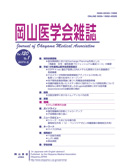

Journal of Okayama Medical Association
Published by Okayama Medical Association<Availability>
Full-text articles are available 3 years after publication.
Permalink : http://escholarship.lib.okayama-u.ac.jp/17065
心臓交感神経刺激による心電図変化 (実験的検討)
原岡 昭一
岡山大学医学部第一内科教室
吉田 英紀
岡山大学医学部第一内科教室
庵谷 和夫
岡山大学医学部第一内科教室
草地 省蔵
岡山大学医学部第一内科教室
西山 修
岡山大学医学部第一内科教室
安原 耕一郎
岡山大学医学部第一内科教室
山田 信行
岡山大学医学部第一内科教室
十河 泰司
岡山大学医学部第一内科教室
藤井 章伸
岡山大学医学部第一内科教室
上田 稔
岡山大学医学部第一内科教室
斉藤 大治
岡山大学医学部第一内科教室
久松 三生
岡山大学医学部第一内科教室
発行日
1980-06-30
抄録
Electrocardiographic and vectorcardiographic changes in Frank's corrected orthogonal lead system were studied stimulating electrically the right stellate ganglion (RSG), the left stellate ganglion (LSG) and both stellate ganglia (LSG+RSG) in anesthetized closed-chest dogs. The effects of propranolol on arrhythmias induced by the stimulation of the cardiac sympathetic nerve were also investigated. The following results were obtained: (1) The amplitude of T wave increased in Y lead with simultaneous stimulation of both right and left stellate ganglia. The spatial maximum T vector was displaced inferiorly and increased in the magnitude in all cases. These electrocardiographic changes were similar to those which occurred with LSG stimulation alone. (2) The rotation of the T loop, in the left sagital plane, was clockwise in more than 80% with RSG stimulation, while the T loop following the stimulation of LSG alone and LSG+RSG rotated counterclockwise in more than 75% of all cases. (3) In more than 40% of cases with stimulation of left cardiac sympathetic nerves (LSG, left ventrolateral cervical cardiac nerve), arrhythmias such as A-V dissociation and A-V junctional rhythm were recognized. Stimulation of right cardiac sympathetic nerve (RSG, right recurrent cardiac nerve) markedly increased the rate of sinus rhythm in more than 90% of cases. These arrhythmias resulted from the stimulation of nerves decreased or disappeared after the intravenous injection of propranolol.
キーワード
心臓交感神経刺激
T波(大きさ,回転)
不整脈
心拍数
ベクトル心電図
ISSN
0030-1558
NCID
AN00032489
